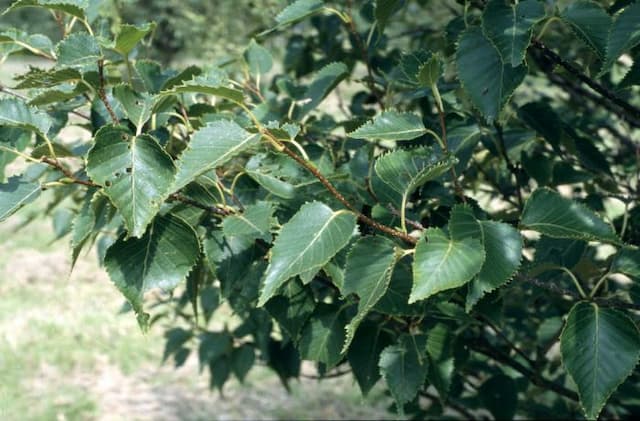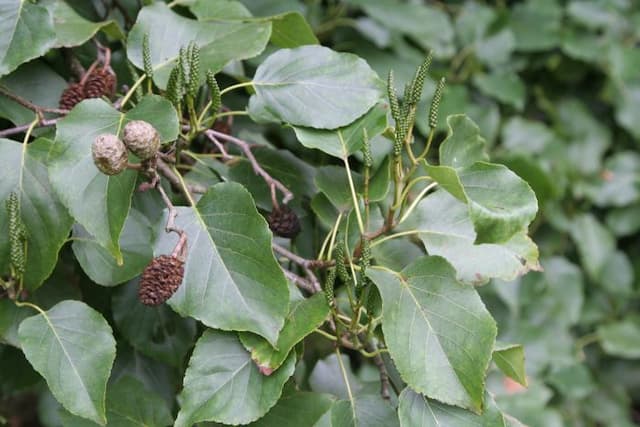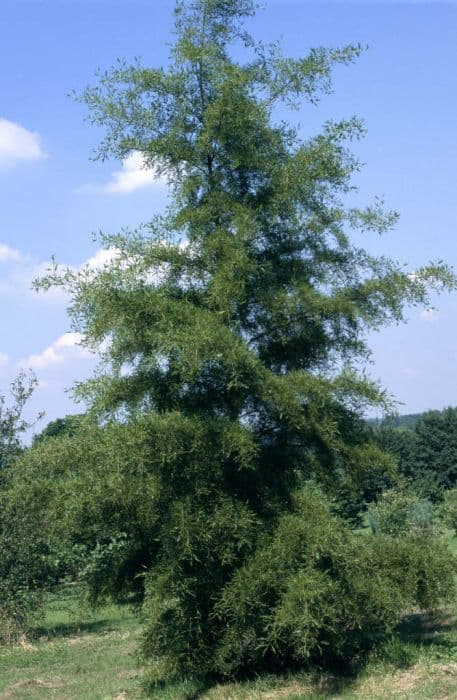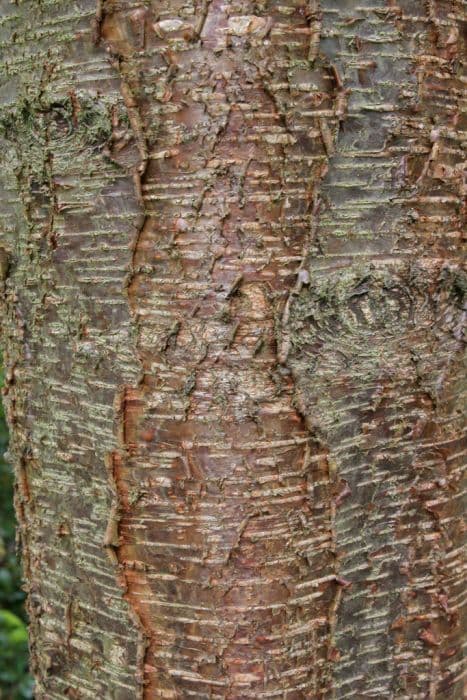Purple Filbert Corylus maxima 'Purpurea' (F)

ABOUT
The Corylus maxima 'Purpurea', commonly known as the purple-leaved filbert or hazelnut, is notable for its richly colored foliage. The leaves are large, round, and double-toothed along the edges. They bear a dramatic purple hue, which can range from a deep, almost black-purple to a brighter, reddish-purple, depending on the light exposure. This bold leaf color serves as a striking backdrop for the plant's other features. In addition to its distinctive leaves, the purple-leaved filbert produces catkins, which are long, slender clusters of flowers. The male catkins are particularly showy, hanging in tassel-like formations that add a decorative touch to the plant in the early spring. These catkins can be yellowish in color, creating a stark and lovely contrast against the dark foliage. The plant also bears fruit in the form of edible nuts that are encased in a tough shell surrounded by a husk. When the nuts mature, they take on a more typical hazelnut appearance, contrasting nicely with the purple leaves. The nuts are not only a visual attraction but also a draw for wildlife. The overall visual appeal of the purple-leaved filbert is characterized by its vivid foliage and the added interest from its flowers and nuts, making it a striking addition to any garden space.
About this plant
 Names
NamesFamily
Betulaceae
Synonyms
Purple Filbert, Red Filbert, Purple Leaf Hazelnut, Purple Hazel
Common names
Corylus maxima 'Atropurpurea', Corylus maxima 'Purpurea'
 Toxicity
ToxicityTo humans
The Purple Leaf Filbert is generally not considered toxic to humans. However, as with any plant material, individual allergies or sensitivities could cause adverse reactions in some people. If you suspect an allergy or an unusual reaction after handling or ingesting the plant, seek medical attention.
To pets
The Purple Leaf Filbert is not known to be toxic to pets. As with humans, individual animals might have allergies or sensitivities that could result in a reaction. If you observe your pet having an unusual response after ingesting this plant, it is best to consult a veterinarian.
 Characteristics
CharacteristicsLife cycle
Perennials
Foliage type
Deciduous
Color of leaves
Purple
Height
15-20 feet (4.6-6 m)
Spread
10-15 feet (3-4.6 m)
Plant type
Shrub
Hardiness zones
4
Native area
Europe
Benefits
 General Benefits
General Benefits- Landscape appeal: The purple-leaved filbert adds a stunning visual interest to gardens with its dark purple foliage that contrasts beautifully with the green of other plants.
- Edible nuts: Produces hazelnuts that are edible and can be used in cooking and baking.
- Wildlife support: Offers food and habitat for wildlife such as birds and squirrels.
- Seasonal Interest: Provides seasonal interest with its changing leaf color throughout the year, catkins in late winter and early spring, followed by edible nuts in the fall.
- Drought tolerance: Once established, it has good resistance to drought and can thrive in a range of soil conditions.
 Medical Properties
Medical PropertiesThis plant is not used for medical purposes.
 Air-purifying Qualities
Air-purifying QualitiesThis plant is not specifically known for air purifying qualities.
 Other Uses
Other Uses- The European filbert 'Purpurea' can serve as a natural dye source; its leaves and catkins can offer unique hues to fabrics and yarns.
- Its wood, being dense and durable, is sometimes utilized in specialized woodworking projects, like crafting small pieces of furniture or intricate carvings.
- Branches of the European filbert 'Purpurea' can be employed as natural stakes or supports for other plants in the garden, especially due to their strength and flexibility.
- During the winter, the nuts left on the tree provide an essential food source for wildlife, including birds and squirrels.
- The tree can be used in coppicing, a traditional method of woodland management, which involves periodically cutting back the tree to stimulate growth and harvest wood.
- In landscape design, its distinctive purple foliage can be used to create striking color contrasts or themed garden sections.
- Wood from the European filbert 'Purpurea' is sometimes used in the crafting of musical instruments for its resonant qualities.
- The catkins, which are the male flowers, are attractive in floral arrangements, adding a unique texture and visual interest.
- Its strong branches are also popular for use in rustic-looking wreaths and other decorative items for home decor.
- Young, flexible shoots from the European filbert 'Purpurea' can be woven to create garden structures like trellises or fencing panels.
Interesting Facts
 Feng Shui
Feng ShuiThe Purple Filbert is not used in Feng Shui practice.
 Zodiac Sign Compitability
Zodiac Sign CompitabilityThe Purple Filbert is not used in astrology practice.
 Plant Symbolism
Plant Symbolism- Protection: Corylus maxima 'Purpurea', commonly known as Purple Filbert, has historically been associated with protection, as hazel trees were believed to ward off evil spirits.
- Wisdom: The hazel tree has been considered a symbol of wisdom and knowledge. In some ancient traditions, hazelnuts were thought to contain wisdom.
- Inspiration: Inspired by the ancient Celtic tradition where hazel nuts were believed to bestow inspiration and creativity, the Purple Filbert can be seen as a representation of artistic thought.
- Reconciliation: Hazel branches, including those of the Purple Filbert, have been used as symbols for making peace and settling disputes.
 Water
WaterPurple Filbert trees should be watered deeply once a week during the growing season, especially if there has been no significant rainfall, with about 1 to 1.5 inches of water. During the fall and winter, reduce watering to every two to three weeks, depending on the weather conditions. It's essential to let the soil dry out slightly between waterings to prevent overwatering, which can lead to root rot. Newly planted trees require more frequent watering, about twice a week, to help establish the roots. Use a soaker hose or drip irrigation to allow water to penetrate deeply into the soil, reaching the tree's entire root system
 Light
LightPurple Filbert desires full sun to partial shade conditions for optimal growth, meaning it thrives best with at least four to six hours of direct sunlight each day. An ideal spot would be an area that receives morning sun and dappled shade in the afternoon, protecting the leaves from the harsh afternoon sun, which can sometimes scorch the foliage
 Temperature
TemperaturePurple Filberts are hardy and can tolerate a range of temperatures but prefer climate zones where the temperature usually stays between 15°F and 75°F. They can endure winter lows down to around -10°F and summer highs up to 100°F without significant damage. The ideal temperature for this plant is typically between 60°F and 75°F during the growing season
 Pruning
PruningPurple Filbert should be pruned to remove any dead or diseased wood, to shape the tree, and to encourage healthy growth and nut production. The best time to prune is in late winter or early spring before new growth begins. Pruning can be done annually, though major pruning should be done more sparingly, about every few years to maintain the tree's structural integrity
 Cleaning
CleaningAs needed
 Soil
SoilFor Purple Filbert, the ideal soil mix is well-draining, rich in organic matter, and loamy. Aim for a soil pH between 6.0 and 7.0. Amend with compost and peat moss to improve fertility and structure.
 Repotting
RepottingPurple Filberts, being large shrubs or small trees, are usually not repotted. They are planted directly in the ground where they have room to grow.
 Humidity & Misting
Humidity & MistingPurple Filbert is adaptable to a wide range of humidity levels and does not require specific humidity conditions when grown outside in its preferred climate.
 Suitable locations
Suitable locationsIndoor
Provide bright light, adequate space, and large container for Purple Filbert.
Outdoor
Plant in well-draining soil, full sun to partial shade for Purple Filbert.
Hardiness zone
4-8 USDA
 Life cycle
Life cyclePurple Filbert, as Corylus maxima 'Purpurea' (F) is commonly known, begins its life cycle when a seed germinates in the soil, typically in early spring. After sprouting, the seedling develops into a young sapling with characteristically purple leaves, which is a notable feature of this cultivar. As it enters the vegetative stage, the woody shrub or small tree establishes a root system and grows stems and foliage, and becomes photosynthetically active. It reaches maturity in a few years and starts to produce catkins, which are the male flowers, and tiny red female flowers, usually by late winter or early spring. Following pollination — often by wind — Purple Filbert forms nuts that are encased in a husk, which ripens and falls to the ground in late summer to early autumn. The nuts may either be harvested for consumption or left to complete the cycle by germinating and growing into new plants.
 Propogation
PropogationPropogation time
Late winter
The most popular method for propagating the Purple Filbert, more formally known as Corylus maxima 'Purpurea', is through hardwood cuttings. This method typically occurs during the plant's dormant season in late fall or winter. To propagate by hardwood cuttings, one must take a cutting of about 8 to 10 inches (20 to 25 centimeters) from a healthy, mature branch. The cutting should have several nodes on it and the lower end is then dipped in rooting hormone to encourage root development. This treated cutting is placed in moist sand or a soil mix, ensuring that several nodes are buried. The pot or tray with the cuttings is then kept in a cold frame or sheltered outdoor area until the following spring, when roots will have formed and the cutting can be potted up or planted out.









